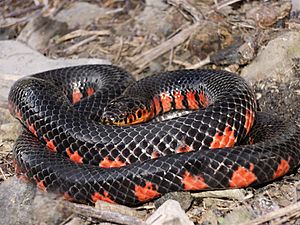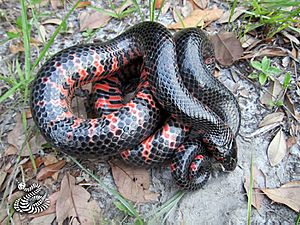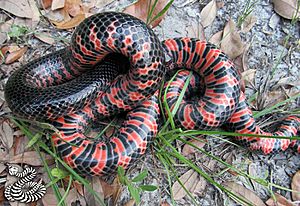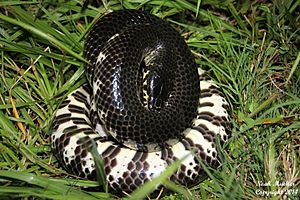Mud snake facts for kids
Quick facts for kids Mud snake |
|
|---|---|
 |
|
| Western mud snake, Farancia abacura reinwardtii, in Illinois | |
| Conservation status | |
| Scientific classification | |
| Genus: |
Farancia
|
| Species: |
abacura
|
| Synonyms | |
|
|
The mud snake (Farancia abacura) is a type of snake that lives both in water and on land. It is not venomous, meaning it does not have harmful venom. These snakes are found only in the southeastern United States.
Contents
What Does a Mud Snake Look Like?
Mud snakes usually grow to be about 40 to 54 inches long (which is about 1 to 1.4 meters). The longest mud snake ever found was over 80 inches (2 meters) long!
Their top side is shiny black. Their belly is a mix of red and black, and the red color often goes up their sides in reddish-pink stripes. Some mud snakes might even be completely black with slightly lighter black spots instead of the red colors.
They have a thick, round body and a short tail that ends in a small, sharp point. The scales on their head are special, with only one scale between their nostrils. The scales on their body are smooth and are arranged in 19 rows around the middle of their body.
Where Do Mud Snakes Live?
Mud snakes live near the edges of streams and cypress swamps. They like to hide among thick plants or under things on the ground. These snakes spend almost all their time in the water. They only leave the water to lay their eggs, to sleep through the winter (hibernate), or if their watery home dries up during a drought.
Mud Snake Behavior
Mud snakes are mostly aquatic, meaning they live in water. They are also nocturnal, which means they are active at night. They mostly hunt and eat large water salamanders, like those from the Siren and Amphiuma groups. They also eat other amphibians.
Mud snakes are known to use their pointed tails to gently poke their prey. This has given them the nickname "stinging snake." But don't worry, their tail is not a stinger and cannot sting you!
Reproduction and Life Cycle
Mud snakes usually mate in the spring, often in April and May. About eight weeks after mating, the female snake lays her eggs. She can lay anywhere from 4 to 111 eggs! She digs a nest in moist soil, sometimes even in alligator nests.
The mother snake stays with her eggs until they hatch. This usually happens in the fall, around September or October. Young mud snakes are often seen entering wetlands in the spring. Scientists think they either go into the water in the fall or wait until spring. It's not fully known if they stay in their nest or move to other land areas during this time.
Where Are Mud Snakes Found?
The mud snake lives in the southeastern United States. You can find them in these states:
- Alabama
- Arkansas
- Florida
- Georgia
- Illinois
- Kentucky
- Louisiana
- Mississippi
- Missouri
- North Carolina
- Oklahoma
- South Carolina
- Tennessee
- Texas
- Virginia
The "Hoop Snake" Myth
The mud snake is one of the animals that might be the reason behind the old myth of the "hoop snake." People used to believe that hoop snakes would bite their own tail and roll after people like a wheel! J.D. Willson wrote about this, saying:
Mud snakes are sometimes known as “hoop snakes” because of the myth that they will bite their own tail and roll after people.
The coachwhip snake is another snake that people thought might be a hoop snake.
Types of Mud Snakes
There are two recognized types, or subspecies, of Farancia abacura:
- Farancia abacura abacura (Holbrook, 1836) – This is called the eastern mud snake.
- Farancia abacura reinwardtii (Schlegel, 1837) – This is called the western mud snake.
Images for kids
See also
 In Spanish: Serpiente del lodo para niños
In Spanish: Serpiente del lodo para niños






